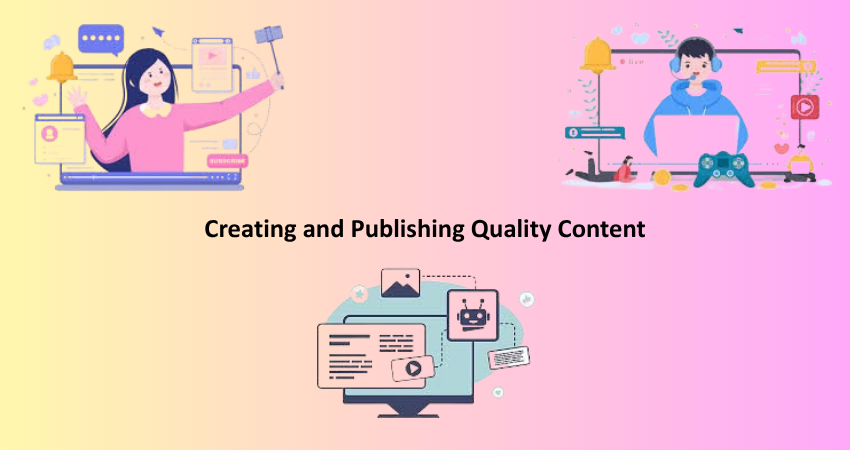
Introduction: Why a Blog is Valuable for Your Website
In current scenario where the world has sped up on digitalization, just having a website is not enough to attract, engage and retain your audience. A good blog if maintained can bring organic traffic from authority and convert visitors to customers. It meant that blog or blogging if given an attachment with existing website has a huge potential to upgrade your digital presence by continuously updating content, targeting specific keywords and showcasing expertise in your domain. Blogs are very versatile and can serve so many purposes- for instance: educating your customers, case studies, announcing new developments, or sharing insights into your industry- the blog has it all. For small businesses or entrepreneurs, for that matter even massive corporations, blogs can be valuable strategic investments that yield fruits for years.
Moreover, it is a well-known fact that search engines prefer websites that are regularly updated with frequently coming quality content. And the best way to achieve that is through blog posts. Each blog post provides an opportunity to rank for certain search keywords, elucidate better what a general consumer could be perplexed about, and advantageously keep users returning to your site. It is this regular content generation that goes a long way towards SEO, strengthens the credibility of your brand, and makes users spend more time on your website. Build community and lead generation or an enhanced customer service; a blog isn’t worth this step to consider introducing it into your website.
Choosing the Right Blogging Platform
Built-In CMS vs. External Blogging Tools
When you are looking to add a blog component to your website, one of the first decisions will be that of the right platform. You are in luck if your site is built on a content management system (CMS) like WordPress, Wix, or Squarespace, for these platforms usually come with integrated blogging capabilities that make for a seamless solution. A built-in one offers a cohesive design, centralized content management, and consistent user experience. It does not require you to juggle different tools or interfaces, and the blog will feel like an extension of your current site. For most users, impartial maintenance and updates, and analytics tracking are easier with an integrated CMS for the website and the blog.
However, companies might still want to talk about some blogging off the internal world through channels like Medium, Ghost, or even LinkedIn Articles. These channels might give some surprise benefits, say a certain niche audience with a very fast publishing workflow. However, a trade-off on control is offered for branding, domain authority, monetization or personalization. Further, any publicity generated for content published externally may not be beneficial to SEO for your main site. Thus, for any company serious about their site becoming a vehicle for growing organic visibility and brand equity, directly integrating the blog into the existing website CMS is likely the better option.
Evaluating Feature Sets and Customization Needs
Once you have selected your CMS or a new platform, the following step is to compare the features you will get from each of the two alternatives. Once again, keep your needs today as well as those of tomorrow in mind. Would you like advanced tools for SEO, rich media integration, commenting system, or scheduling posts? Some blog engines provide features that afford flexibility and customization. For example WordPress, one of those blogging engines, provides a huge library of themes and plugins, allowing users to mold the blog into every shape imaginable. Enhance the readability, optimize for the search engines, and create interactive experiences to keep users engaged.
Customization includes a design layout. Your blog should match the branding of your other forms so that it becomes part of a universal visual identity. Look for the platforms that offer you font color navigation post formatting. If you are working with developers, ensure the required platform covers their languages and frameworks the site already works. The most flexible and powerful blog will make sure your blog has the power to grow with your business. In the long term, A well-customized blog helps build credibility among users, results better user experience, and produces increased ROI out of your content efforts.
Setting Up the Blog Structure

Planning Categories and Navigation
Planning out the structure of a blog before starting to put up content should be the first step. This starts with categories that are going to organize your posts in the logical sense, which typically would be main topics that will be covered in your content strategy. A category reflects some of the major topics you are going to address. A fitness site could have categories such as “Workouts,” “Nutrition,” and “Mental Health.” By clearly outlining intuitive categories, it becomes easy for the users to find content on the site and encourages them to explore deeper. You also do not want to create an overwhelming amount of categories as this can confuse a visitor when trying to find a particular item. Start with a couple of core themes and grow as your content expands.
With the categories defined, apply them now to the navigation of your site. The dedicated “Blog” menu item will link to the main blog page which can then itself feature category filters or dropdowns. That’s really just a back end accessibility and usability thing – I’ve talked about making the blog more functional in user journeys. That consistency then comes down to naming and presentation, which users learn to expect from categories. But well-thought-out structure is also good for SEO because it allows search engines to crawl and index your content better. The planning prevents future time wastage and maintains a clean, user-friendly layout as your blog matures.
URL Structure and Permalinks
An important aspect of creating your blog is the URL structure, or better known as permalinks. A clean, descriptive URL structure aids SEO and allows users to instantaneously grasp the content of a specified page. For instance, yourdomain.com/blog/how-to-start-yoga gives users more pertinent information than yourdomain.com/post?id=12345. Most CMS platforms offer some customization of permalink settings. A clearer, keyword-conducive structure will be one where the blog category and title are included.
For the sake of uniformity, permalinks should be consistent across your blog. Only use dates if absolutely necessary, as this can quickly age content that is still relevant. Shorter URLs tend to perform better, so keep them as short as possible while still getting in on the act with a few keywords. The shorter URL addresses are a better bet for search engines and higher click-through rates. Have a solid plan in place for the old URLs to avoid breaking links. Always use proper redirects, and avoid making changes to permalinks except for very rare occasions. A proper URL structure assures SEO and triggers an element of user trust, which thereby establishes a solid background for long-term success.
Designing the Blog Layout and User Experience
Consistency with Website Branding
Your blog must look consistent with the rest of your website to have a cohesive brand experience, including fonts, color schemes, style of headers, and navigation elements in use. The consistency creates an assurance for the visitors that they are still on your website, thereby fostering trust and lowering the bounce rates for your site. An integrated blog feels like a section of the site, rather than being a lonely alien outpost of that site. It thereby helps strengthen the brand identity and ensures that any user receives a consistent message of sorts, no matter the page they land upon.
To start, customize your blog theme with your website’s style. Include your logo; keep the spacing consistent; and try to keep the same layout grid. Avoid generic themes that seem out of place. Things like your tagline or mission statement will reinforce the familiarity even more. The consistency must also go on to include the tone of voice and style of the content. Whether it is more of an academic tone or a chatty tone, maintain it consistently right across every blog post. A blog that continues to be stereotypically and visually in harmony with the rest of the brand gives extra support to that chosen brand and, of course, high-level user experience.
Enhancing Readability and Accessibility
Readability and accessibility should be the foremost priorities for your blog besides its visual design. While at it, break the texts into very short paragraphs, formulate clear headings, and engage in using bullet points or numbered lists to the appropriate extent. High readability will guarantee that users scan for and extract takeaways easily. Use legible fonts, at appropriate sizes, and maintain enough contrast between text and background. All these little things combined will go a long way with user engagement.
Accessibility shouldn’t be an afterthought. Your blog should also meet the standard with regard to accessibility: those defined in the WCAG guidelines. An image should have alt text, whereas a video should have a transcript, and the entire layout should be navigable through the keyboard. These attributes are beneficial to users with disabilities and contribute to the overall usability of your website. Another major feature here is mobile responsiveness: your blog should display properly across different devices, adjusting images and text for size to fit smaller screens. Readability and accessibility have improved the experience of users and reduced their bounce rates, thus enlarging their reach with a wider audience.
Creating and Publishing Quality Content

Establishing a Content Strategy
The chances of reaping adequate results by publishing random blog posts are very low. You need a content strategy that would integrate business objectives with audience interests. Begin by defining the target audience. What are their pain points, questions, and goals? With this information, create content pillars-broad themes that support the brand message. If a digital marketing agency were to choose such pillars, it would likely mention SEO, social media, and email marketing. These pillars will serve to define topics while ensuring consistency in content.
Once the pillars are set up, a calendar has to be created that provides a skeleton for the organization of content creation. Topics will almost always be worked on or assigned even before this publication date; the calendar must state the content types that will be shared: how-to, listicles, commentaries, etc. The calendar organizes your blog and ensures hours of content are added on a regular basis, which is key to gaining an audience. Balancing evergreen versus timely posts will help generate long-term and seasonal traffic on the blog. Use analytics to measure audience engagement, noting which subjects resonate and which to avoid. With the seams of content strategy being drawn and stitched, data will help you create something of value toward engaging your audience so that business goals can be fulfilled in the end.
Optimizing Posts for SEO and Engagement
Good content should be made discoverable, and that is why SEO optimization is an essential in the whole process. Conduct keyword research to find out the keywords your audience is searching for, and fit them naturally, into your headlines, titles, and body text. Add meta descriptions, alt text for images, and internal links to related content pages. These deepen the understanding of search engines toward your content and provide a stronger opportunity for your site to rank higher in search results. Avoid keyword stuffing, strive to provide relevant and value adding information regarding user intent query.
Another key aspect is engagement. Write post titles that compel one to read the rest of the article, and add such things as photos, infographics, and videos. Each post should have a robust call-to-action (CTA), either to sign up for a newsletter, download a resource, or simply comment on the article. Include social sharing options and emphasize quotable snippets in encouraging social sharing. Adds interactive elements such as polls or embedded tweets. It is said-and heavenly upon man-to be a very good treasure to the SEO and engagement; the more engaging your post is, the more it will most probably click-it up in search and later retain the reader’s consideration.
Conclusion: Turning Your Blog Into a Business Asset
Adding a blog to an existing site is not merely a technological upgrade; it is a strategic maneuver that will reinvigorate your entire online presence. A well-crafted blog establishes credibility, nurtures SEO, and facilitates a deeper connection with your audience. Choosing a platform for your blogs involves much more than purely formatting the content or optimizing for performance; it means creating a lasting resource. A blog also allows you to share your knowledge, dispassionate their concerns, and impart that knowledge, thus branding you as a real thought leader.
Though achieving success never happens overnight. For a business to reap the rewards of blogging, consistency, quality, and user-focused execution are key. Treat the blog as an integral part of the website, not an afterthought. Visually integrate it, make it part of your content strategy, and do constant improvements. With time and dedication, your blog can develop into a robust machinery for traffic, engagement, and conversions. It is one of the cheapest business growth powers around, with the greatest impact on your digital footprint.